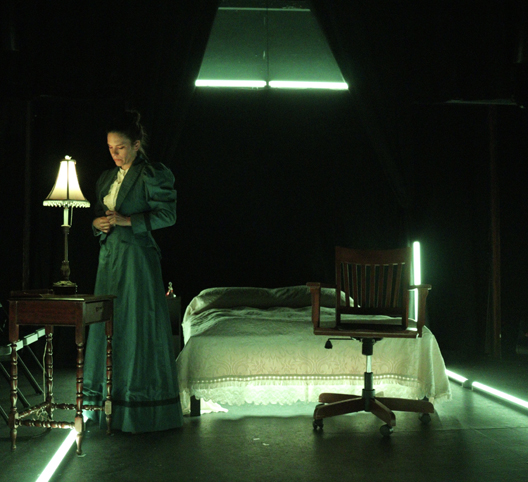A Woman Silenced and Maddened
By Alix Cohen
Written in 1892, The Yellow Wallpaper was published as a series of diary entries by an unnamed woman suffering from postpartum depression. Her physician husband, John, prescribes a “rest cure,” confining her to a nursery with barred windows and forbidding her from writing or engaging in stimulating activity.
As her isolation deepens, she becomes obsessed with the room’s yellow wallpaper, perceiving a trapped woman within its chaotic patterns—a reflection of her own mental imprisonment.

In the 19th Century, it was common for men to institutionalize women in their lives who did not conform to their will. Literature, film, and music depict victims both historical and fictionalized. There was no rigorous medical or legal review. Doctors often reinforced patriarchal norms, diagnosing women with vague or fabricated conditions that justified confinement. Allegations of “hysteria,” “melancholia,” or “moral insanity” were sufficient.
Nonconforming women who expressed sexual autonomy, refusing marriage, or engaging in political activism were often labeled mentally ill. This was especially true for the outspoken, suffragists, or those resisting domestic roles. Once institutionalized, women were socially erased. Their reputations were tarnished, making public advocacy or family support unlikely.
This heroine’s husband has not formally incarcerated her- yet- but teeters on similarity of situation. Does he truly feel he’s helping by depriving her of “normalcy” she might still enjoy-all but imprisoning the young woman, or is there ulterior motivation? Raised in a class and era that defers, she presumes he’s acting in her best interest.
In a consummate performance with amorphous fourth wall, Susannah Millonzi inhabits progression of madness fostered by admonition, nerves and near quarantine. There are times she unabashedly glares at us trying desperately to share her suffering, perhaps subliminally calling for help, and other times during which obsession swallows her whole. Pacing, which adds to our discomforted empathy, is inspired.

In the course of the piece, the woman disrobes down to underthings ridding herself of what restriction is still in her power. A pendulum swing of brief pleasure she gets when allowed social intercourse or a walk in the garden, and increasing delusions emerge visceral.
Always exhausted, in a last effort to simulate routine and achieve a fraction of dominion over her state, she nonetheless exercises. The actress vividly conveys defeat periodically collapsing into bed like a deflated balloon.
By description the wallpaper- wisely not depicted, may be a toile: patterns typically depict intricate line-drawn scenes—such as countryside landscapes, mythological figures, or domestic vignettes. Millonzi practically conjures the peeling, discolored subject of her fixation.
During one parenthesis she scrapes her nails against the wall behind her bed in desperate attempt to release the mirror woman. Intensity, grating sound, and balletic direction is physically as well as emotionally consuming. The actress almost mates with a wall.
Progression of phobia which may be weeks or months, feels like it’s happening in real time. Audience is riveted. There’s not a cough or rustle in the theater. The play’s ending, not quite what it is in the book, leaves us alarmed.
Acting and directing are masterful. Any professional would learn from this collaboration. Audience observes with baited breath. The production is accomplished and brave.

Modern mental health discourse has evolved, but vestiges of these gendered frameworks persist: Women are still more likely to be diagnosed with depression or anxiety, while men are under-diagnosed for the same. Emotional intensity in women is sometimes misread as instability, echoing 19th-century tropes. Marginalized women—especially immigrants and women of color—face disproportionate scrutiny and institutionalization, often under vague behavioral criteria.
A bed, a chair, a table and neon light tubing create confinement and signal mood change.
Costume Design by Sam DeBell is period perfect, aesthetically pleasing, and dramatically practical.
Joe Sinkovits (Sound Design) and Hunter Lustberg (Lighting Design) work symbiotically to create disturbing atmosphere coordinated with the heroine’s mercurial state.
Photos by Rose Gonzales
Bedlam & wayward son present
The Yellow Wallpaper
Adapted by Susannah Millonzi & Caitlin Morely
From the classic story by Charlotte Perkins Gilman
Directed by Caitlin Morely
Choreography by Susannah Millonzi
Through December 7, 2025
West End Theatre, 263 W. 86th Street
info@theatrebedlam.org


